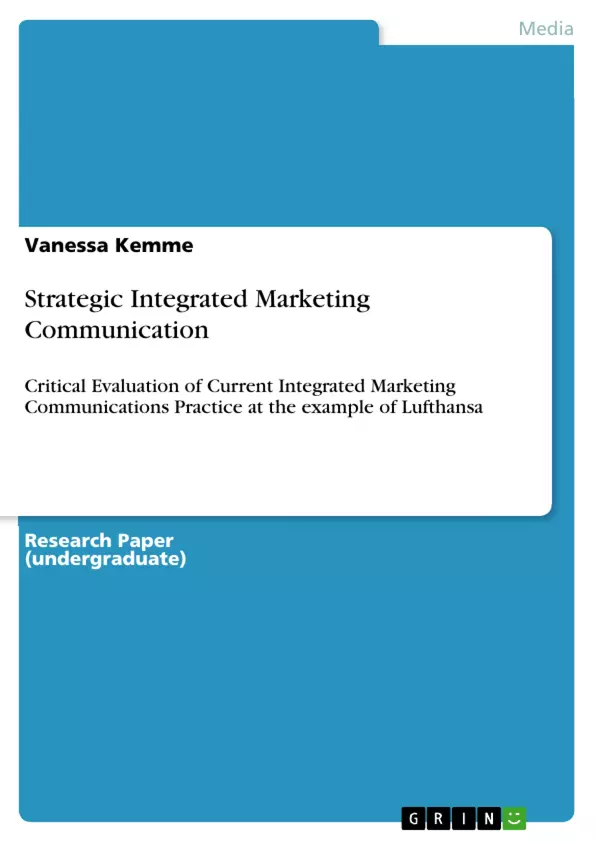In every area of science, economy and industry communication is used to create a significant message and to build relationships between sender and receiver. Especially when it comes to the science of marketing, communication is used in various forms that are managed and channelled consistently by strategic integrated marketing communications (IMC). Primarily introduced in the 1980s as a marketing strategy, IMC today plays a major role in many organisations corporate strategy, including the German company Lufthansa.
The following essay will outline this marketing strategy by its theory and will apply it to the strategy of Lufthansa in three parts. Thereby the first part will illustrate the theoretical background of IMC regarding to its role and concept and its relations to other areas of marketing and business management. These findings will primarily be based on secondary research of literature from Kotler, Percy and Fill which will be sustained by the work of other authors. The second part of the essay will enlarge this theory by the approach of the communication mix and will transmit it to the practise of the German company Lufthansa. As the company is constituted as the Lufthansa Group and various sub companies the author will concern the business segment of passenger transport that is carried out by Lufthansa Passenger Airlines, in the following named Lufthansa. This business segment will be analysed for its integrated marketing communication strategy “Nonstop you” as part of the “7 to 2-our way forward” marketing program of Lufthansa Group.
This analysis of the current strategy will lead over to recommendation within the third part of the essay, by providing an additional concept that will be described by the SOSTAC model. Within six elements the author will illustrate a communication strategy for a new target group that creates a message and builds relationship between Lufthansa and the Generation Y.
Inhaltsverzeichnis (Table of Contents)
- I. Executive Summary
- II. Table of Content
- III. Figures
- 4. Integrated Marketing Communications
- I
- II
- III
- 5. Marketing communication mix by the example of Lufthansa
- 5.1. Advertising
- 5.2. Public Relations
- 5.3. Sales Promotion
- 5.4. Personal selling
- 5.5. Direct marketing
- 6. SOSTAC and Recommendations
- 6.1. Situational Analysis
- 6.2. Objectives
- 6.3. Strategy
- 6.4. Tactic
- 6.5. Action
- 6.6. Control
- VII. Reference List
- VII.I. Books
- VII.I. Online
- VIII. Appendix
- VIII.I. Appendix A: SWOT Analysis
Zielsetzung und Themenschwerpunkte (Objectives and Key Themes)
This essay examines the theory and practice of integrated marketing communications (IMC) using the example of the German airline Lufthansa. It aims to analyze the strategy behind Lufthansa’s "Nonstop you" campaign, a component of the "7 to 2-our way forward" marketing program of the Lufthansa Group. The essay investigates the role of IMC in building relationships with consumers and explores the communication mix used by Lufthansa.
- The theoretical underpinnings of IMC and its evolution from a marketing tool to a management tool.
- The application of IMC in practice, with a specific focus on the Lufthansa Group’s “Nonstop you” campaign.
- The various elements of the communication mix, including advertising, public relations, sales promotion, personal selling, and direct marketing.
- The use of the SOSTAC model for developing a communication strategy targeted at Generation YII.
- Recommendations for enhancing Lufthansa’s integrated marketing communications strategy.
Zusammenfassung der Kapitel (Chapter Summaries)
The first chapter defines integrated marketing communications (IMC) and its historical development. It highlights the shift from a focus on individual marketing channels to a customer-centric approach that emphasizes building relationships. The chapter discusses the role of IMC in creating consistent brand messages across various communication platforms.
The second chapter examines the application of IMC in practice, specifically analyzing Lufthansa’s “Nonstop you” campaign. It explores the different communication channels used, including advertising, public relations, and digital media. The chapter also assesses the effectiveness of these channels in reaching target audiences and building brand loyalty.
The third chapter delves into the elements of the communication mix. It examines the different types of advertising employed by Lufthansa, discusses the importance of public relations in managing brand reputation, and explores the role of sales promotion and direct marketing in engaging customers. The chapter concludes with an analysis of the challenges and opportunities associated with personal selling in the airline industry.
Schlüsselwörter (Keywords)
Integrated marketing communications (IMC), Lufthansa, communication mix, advertising, public relations, sales promotion, personal selling, direct marketing, SOSTAC model, Generation YII, customer relationship management, brand strategy, marketing communication.
- Quote paper
- Vanessa Kemme (Author), 2017, Strategic Integrated Marketing Communication, Munich, GRIN Verlag, https://www.grin.com/document/426219



